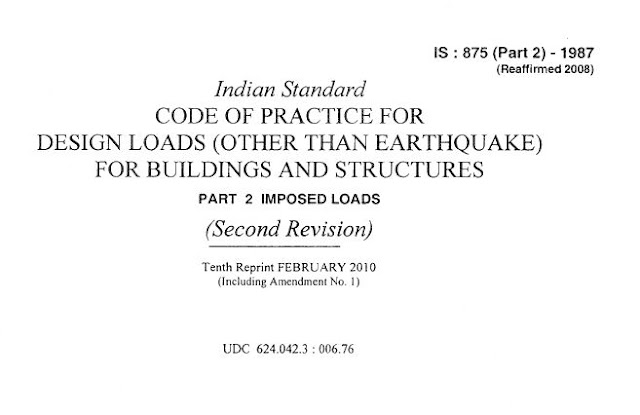CODE OF PRACTICE FOR DESIGN LOADS (OTHER THAN EARTHQUAKE) FOR BUILDINGS AND STRUCTURES PART 2 IMPOSED LOADS
This Indian
Standard ( Part 2 )
( Second Revision )
was adopted by the Bureau
of Indian Standards on
31 August 1987 after
the draft finalized by
the Structural Safety
Sectional Committee had
been approved by the
Building Division Council.
A building
has to perform many functions satisfactorily. Amongst these functions
are the utility of
the building for
the intended use and
occupancy, structural safety,
fire safety; and compliance
with hygienic, sanitation,
ventilation and day
light standards.
The design of the building is dependent upon the minimum requirements prescribed for each of the above functions. The minimum requirements pertaining to the structural safety of buildings are being covered in this Code by way of laying down minimum design loads which have to be assumed for dead loads, imposed loads, snow loads and other external loads, the structure would be required to bear.
Strict conformity to loadings standards recommended in this Code, it is hoped, will not only ensure the structural safety of the buildings which are being designed and constructed in the country and thereby reduce the hazards to life and property caused by unsafe structures, but also eliminate the wastage caused by assuming unnecessarily heavy loadings.
The design of the building is dependent upon the minimum requirements prescribed for each of the above functions. The minimum requirements pertaining to the structural safety of buildings are being covered in this Code by way of laying down minimum design loads which have to be assumed for dead loads, imposed loads, snow loads and other external loads, the structure would be required to bear.
Strict conformity to loadings standards recommended in this Code, it is hoped, will not only ensure the structural safety of the buildings which are being designed and constructed in the country and thereby reduce the hazards to life and property caused by unsafe structures, but also eliminate the wastage caused by assuming unnecessarily heavy loadings.
This Code was first published in 1957 for the guidance of civil engineers, designers and architects associated with the planning and design of buildings. It included the provisions for the basic design loads ( dead loads, live loads, wind load sand seismic loads )to be assumed in the design of buildings.
In its first revision in 1964, the wind pressure provisions were modified on the basis of studies of wind phenomenon and its effects on structures, undertaken by the special committee in consultation with the Indian Meteorological Department. In addition to this, new clauses on wind loads for butterfly type structures were included; wind ,pressure coefficients for sheeted roofs, both curved and sloping, were modified; seismic load provisions were deleted ( separate code having been prepared ) and metric system of weights and measurements was adopted.
With the
increased adoption of
the Code, a number
of comments were
received on the
pro-visions on live
load values adopted
for different occupancies.
Simultaneously live load surveys have been carried out in America and Canada to arrive at realistic live loads based on actual determination of loading ( movable and immovable )in different occupancies. Keeping this in view and other developments in the field of wind engineering, the Sectional Committee responsible for the preparation of the Code has decided to prepare the second revision of IS : 875 in the following five parts :
Simultaneously live load surveys have been carried out in America and Canada to arrive at realistic live loads based on actual determination of loading ( movable and immovable )in different occupancies. Keeping this in view and other developments in the field of wind engineering, the Sectional Committee responsible for the preparation of the Code has decided to prepare the second revision of IS : 875 in the following five parts :
Part 1
Dead loads
Part 2 Imposed loads
Part 2 Imposed loads
Part 3 Wind
loads
Part 4 Snow
loads
Part 5 Special
loads and load combinations.

![Different Applications of GIS [ Geographical Information System ]](https://blogger.googleusercontent.com/img/b/R29vZ2xl/AVvXsEhHuGl0hPEHKOfNPmTyBacOw3n4QQS54eRbfvEJfHxbOdImzfdroP0ab3tvCp98S2P8ZvJWqiz1clCwaQGVp2i9t9Nq4UkvRgcIR9X_chyphenhyphenkBJmhr4UIJRs4Jw0ppSn6jn56sVfBed4j9i7J/w100/8113229957_421c837a06_b.jpg)

![[PDF] Download IS 800 1984 | Civil Engineering Codes](https://blogger.googleusercontent.com/img/b/R29vZ2xl/AVvXsEiASJRvscBgyiE77vGXAXbgpreeQU2ym16bHBEVolAj6CciEV8R5BvsymmeXfRFc6xGoOe6KUN4_il3hx5F0jUPVA2cSUcxJynmhMDej21CbiYhi0VcyR-qgPRCXVAcv1oobWdG_nvoOW7S/w100/IS-800-1984.PNG)
![[PDF] Download IS 800 Code | Indian Standard Code for Steel](https://blogger.googleusercontent.com/img/b/R29vZ2xl/AVvXsEjMmVdQd3q6sKYLbOG23DVJg2U_8IrdWJSfCcyA7gKs5NKVFBsi6dFPhGxoVctqzOHEIvJ6pqvQ6mpFMd5vV0U5IQHo-FETwRXTjbZ-Dok9CHxUJgePxHyFTHa2pNiWyW4mkYCJWOv_2IcP/w100/is-800-2007.JPG)


![[PDF] SP 16 :1980 Design Aids For Reinforced Concrete to IS : 456-1978](https://blogger.googleusercontent.com/img/b/R29vZ2xl/AVvXsEj3vWyWR9sVpY2Mcip5F3ttq_4jje6Et0mqiBug-q8n7kClvXle3KD0XtZBwYBtmYFfIekvQYIW9gFB5aqcri6KrHD4x2PalOyEWAXPkLNFfbXe8m9m8WvCLSEWok7vPivvYidB1tj8JjeX/w100/is-sp-16-1980.JPG)
![[PDF] IS 456 2000 | Download Civil Engineering Code](https://blogger.googleusercontent.com/img/b/R29vZ2xl/AVvXsEjl8mzhZI_smGwhJPipCx2TuxHldgAvnHrYfkud8mDJ1kF4Syd83-TNKsXjyY1BVxFrxZ1tt-fErpupgiF146wqOfPtGo8M9GWrnQX9b9TyA-YtjlNWnlwdk9LaMN_JJN8AGCU619UI6Uu_/w100/is-456-2000.JPG)

0 Comments